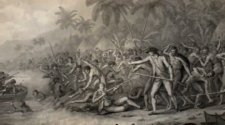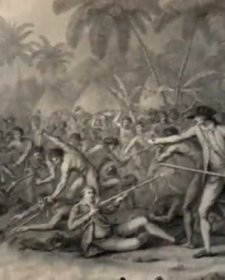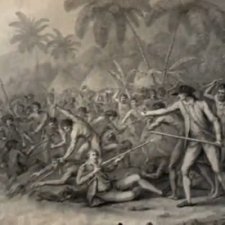- About us
- Support the Gallery
- Venue hire
- Publications
- Research library
- Organisation chart
- Employment
- Contact us
- Make a booking
- Onsite programs
- Online programs
- School visit information
- Learning resources
- Little Darlings
- Professional learning
This work is a depiction of the affray which took place in Kealakekua Bay, Hawaii, on 14 February 1779, in which Cook, four marines, and seventeen Hawaiians lost their lives. Two and half years into his third voyage and having circumnavigated the largest island of Hawaii, Cook anchored his ships, Resolution and Discovery, in Kealekekua Bay in January 1779. The voyagers were welcomed, and relations between the Hawaiians and Europeans remained largely peaceful during the expedition's stay. Shortly after departing Kealekekua, however, Cook returned to make repairs and relations then deteriorated. Things came to a head when Cook decided to force the return of a stolen ship's cutter by taking the Hawaiian king hostage. He went ashore with ten men to bring the plan into effect; shots were fired in the confusion and a Hawaiian chief was killed. Cook and his men were attacked as they retreated to their boats; Cook shot and killed another warrior and in return was stabbed.
News of Cook's demise reached England ahead of the return of the expedition and quickly became the subject of souvenir images. Originally it was claimed that this work was based on drawings made by James Cleveley, who was the carpenter on the Resolution. It is now believed, however, that the work is an invention devised by Cleveley’s brother, John, from other images and accounts of Cook’s death.
Purchased with funds provided by the Liangis family 2012
Mrs Sortiria Liangis AM (12 portraits supported)



On one level The Companion talks about the most famous and frontline Australians, but on another it tells us about ourselves.



Betty Churcher describes the creation of the portrait of Captain James Cook in the National Portrait Gallery.



An exploration of the role of artists such as John Webber who, whilst a member of Cook’s crew over many voyages, created paintings and drawings of the situations and people the explorers encountered.